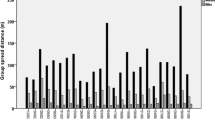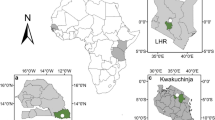Abstract
Two measures of group activity were assessed using 14 captive groups of pigtail monkeys (M. nemestrina). Absolute frequencies of movement of individuals (a direct measure of activity) was used as a criterion in the evaluation of a sampling technique (an indirect measure of activity). The indirect measure involved monitoring the frequency of movement of individuals past a fixed point in the environment. The indirect measure correlated highly with the criterion measure (r=.91). use of indirect measures of activity such as the one described here can increase the efficiency of data collection by allowing observers sufficient time to monitor a greater range of behaviors. However, sampling techniques should be carefully evaluated in an appropriate context before they are adopted for general use.
Similar content being viewed by others
References
Bobbitt, R., G. Jensen, &B. Gordon, 1964. Behavioral elements (taxonomy) for observing mother-infant-peer interaction imMacaca nemestrina.Primates, 5: 71–80.
Bowden, D. &W. McKinney, 1972. Behavioral effects of peer separation, isolation, and reunion on an adolescent male rhesus.Develop. Psychol., 5: 353–362.
Brandt, E. &G. Mitchell, 1973. Pairing preadolescents with infants.Develop. Psychol., 8: 222–228.
Erwin, J., T. Maple, G. Mitchell, &J. Willott, 1974. Follow-up study of isolation-reared and mother-reared rhesus monkeys paired with preadolescent conspecifics in late infancy: Cross-sex pairings.Develop. Psychol., 10: 808–814.
Farrer, D. &J. Ternes, 1969. Illumination intensity and behavioral circadian rhythms. In:Circadian Rhythms in Nonhuman Primate (Bibliotheca Primatologica, Vol. 9),F. Rohles (ed.), S. Karger, Basel, pp. 1–7.
Rosenblum, I., R. Clark, &I. C. Kaufman, 1964. Diurnal variations in mother-infant separation and sleep in two species of macaques.J. comp. physiol. Psychol., 58: 330–332.
Author information
Authors and Affiliations
Additional information
This project was supported in part by each of the following grants: an intramural grant from the University’s Innovative Fund for under-graduate education to the Department of Psychology, and USPHS/NIH grants RR00166 to the Regional Primate Research Center, and HD08633, toGene P. Sackett, Child Development and Mental Retardation Center, University of Washington.
About this article
Cite this article
Martenson, J.A., Oswald, M. & Erwin, J. Measures of activity in captive monkey groups. Primates 18, 601–604 (1977). https://doi.org/10.1007/BF02383137
Received:
Accepted:
Issue Date:
DOI: https://doi.org/10.1007/BF02383137




